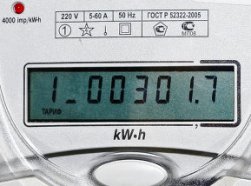Categories: Controversial issues, Energy saving
Number of views: 63738
Comments on the article: 12
Multi-tariff accounting: where are the problems “buried”?
 The article discusses the reasons for the weak interest of enterprises and the population in the transition to multi-tariff, time-differentiated metering of electricity.
The article discusses the reasons for the weak interest of enterprises and the population in the transition to multi-tariff, time-differentiated metering of electricity.
We rarely think that electricity is the most perishable product known to mankind today. If it is not used immediately, then in a moment it disappears, and with it the uselessly burned gas, coal, heat of TVELs at nuclear power plants. Therefore, a balanced energy consumption is the main task and a headache for energy.
It is possible to compensate for seasonal variations in energy consumption by power plants. But to smooth the diurnal fluctuations - such a task for generating stations is practically impossible. This problem must be solved by consumers: enterprises and the population. To this end, in the CIS countries for many years trying to introduce electricity metering at tariffs that vary depending on the time of day.
Necessity to dwell on the concept and possibilities multi-tariff metering of electric energy no special need. Firms that sell electronic meters talk in detail about the advantages of such metering, citing fantastic amounts of savings on energy bills and the shortest payback periods for their meters.
The technical capabilities of organizing multi-tariff electricity metering have long been realized: the list of models of electronic meters on the market is so diverse that the difficulty is not to find a meter, but to choose the right model from dozens with different prices.
In almost all CIS countries, a regulatory framework has been adopted that allows organizing multi-tariff accounting, i.e. and on this side there are no obstacles. Nevertheless, the number of enterprises and organizations that have switched to multi-tariff accounting has so far not exceeded 5% of the total number of consumers.
Even less on multi-tariff accounting of household consumers. More precisely, there are practically none. Some enthusiasts and thrill-seekers who have gone through all the bureaucratic procedures and pay for energy at zone tariffs unanimously claim the disadvantage of such an accounting system. So why can such a useful system that has been working abroad for decades not take root with us?
Let's try to find the main reasons that impede the implementation of multi-tariff accounting. To begin, consider the boundaries of daily tariff zones (for example, Ukraine) and the multipliers to the cost in relation to the single-entry tariff. For a two-part tariff for the population, this multiplier is 0.7 at 8 hours of a night (reduced rate) and 1 rest of the day. For enterprises with a three-part tariff, multipliers of 0.25 (night 7 hours); 1.02 (half-hour 11 hours), and 1.8 (peak, 6 hours).
Mentally, we turn on the constant load for a day, say, 1 kW, and in this case we will see what advantages multi-tariff metering will have compared to single-rate metering. For the population, this value will turn out + 10%, i.e. with a constant load, a two-part tariff is advantageous. A similar calculation of the zones for legal entities will give as much as + 0.99% gain!
In practice, one can only dream of redistributing the load among consumers in the preferential area of the day. How many people want to wash, vacuum, or watch TV from 11 p.m. to 7 a.m.? And what will the neighbors in the apartment tell you who need to go to work early in the morning?
Things are not the best in enterprises. With the exception of bakeries and other enterprises with a night work cycle, other legal consumers adjust to our wakefulness and will not be able to shift their workloads at night.In addition, employees must pay extra for work in the evening and at night, and these surcharges will inevitably “eat up” a significant part of the savings in energy payments.
There is another reason that makes the prospect of introducing multi-tariff metering illusive - the price of electricity in the CIS countries, especially for the population. If in Denmark families pay $ 0.39 for 1 kW / hour, then in Russia 7 cents, and in Ukraine in general 3 cents. Such a low price is unlikely to stimulate the population to switch to a nocturnal lifestyle.
What is the way out? For the population, as it does not sound blasphemous, the “carrot and stick” method is necessary. For this, it is necessary to expand the zone of the preferential tariff for electricity up to 12 hours, highlighting the daily “window” in the zone of half-peak loads. This is the carrot. A whip is a sharp increase in the cost of electricity to a level that is established by legal entities. The population will use cheap energy within 4 days and get used to the features of multi-metering.
And one more condition. Electronic meters for the public should have communication channels with energy-transmitting organizations for remote reading. Imagine a senior citizen, taking readings on tariff zones, multiplying the testimony by coefficients, summarizing the results ... Those who happened to visit the sales department of RES for at least once, it will be very difficult to believe the reality of the picture described above
For legal entities, there is even less room for maneuver. Industrial enterprises have only one way out - the replacement of equipment with modern, automated, with minimal human participation in production processes. To carry out such modernization with an incentive of 0.99% on the payment of energy is a profanity. Therefore, it is necessary to expand the zone of preferential, nightly tariffs to obtain 10-15% savings, as it was at the beginning of the first decade of the century in Ukraine. Without these decisions, it would be naive to expect serious results from the introduction of multi-tariff metering of electric energy for the population and for legal entities.
See also at bgv.electricianexp.com
:
